Keratin Market
Keratin Market Size and Share Forecast Outlook 2025 to 2035
Keratin market is projected to grow from USD 2.8 billion in 2025 to USD 5.7 billion by 2035, at a CAGR of 7.4%. Hydrolyzed Keratin will dominate with a 52.4% market share, while hair care products will lead the application segment with a 61.3% share.
Keratin Market Forecast and Outlook 2025 to 2035
The global keratin market is valued at USD 2.8 billion in 2025 and is set to reach USD 5.7 billion by 2035, growing at a CAGR of 7.4%. The market stands at the forefront of a transformative decade that promises to redefine protein-based cosmetic formulations and advanced hair care technologies across beauty applications, personal care manufacturing, and specialized treatment platforms.
The market's journey from USD 2.8 billion in 2025 to USD 5.7 billion by 2035 represents substantial growth, demonstrating the accelerating adoption of keratin-infused products and advanced protein treatments across cosmetic operations, beauty salon services, and critical hair restoration applications.
Quick Stats for Keratin Market
- Keratin Market Value (2025): USD 2.8 billion
- Keratin Market Forecast Value (2035): USD 5.7 billion
- Keratin Market Forecast CAGR: 7.4%
- Leading Type in Keratin Market: Hydrolyzed Keratin (52.4%)
- Key Growth Regions in Keratin Market: Asia Pacific, North America, and Europe
- Key Players in Keratin Market: Croda International, Keraplast Technologies, Roxlor
- Keratin Market Year-over-Year Forecast (2025-2035)
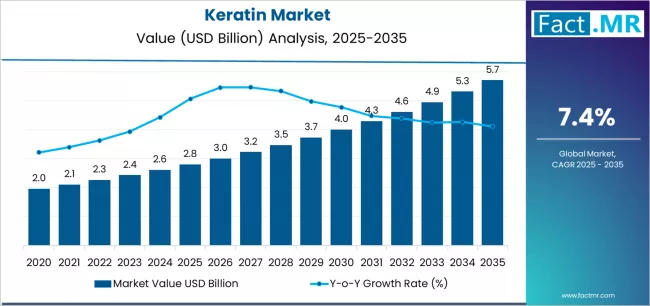
Personal care sector modernization continues to accelerate adoption of keratin formulations, with industries ranging from professional hair care to premium beauty products implementing these proteins as critical components in hair strengthening systems. The growing emphasis on hair damage repair, protein restoration, and performance enhancement creates continued demand for keratin solutions that deliver consistent results while reducing hair breakage and improving overall hair quality. Keratin addresses these needs through advanced extraction technologies, enhanced protein capabilities, and robust formulations that withstand demanding salon and home-use applications while providing superior hair conditioning and restoration performance.
Regional market dynamics reveal distinct growth patterns influenced by beauty industry development levels, hair care spending capabilities, and protein treatment adoption rates. Developed markets in North America and Europe demonstrate steady growth driven by premium hair care trends, salon modernization cycles, and advanced beauty processes that prioritize high-quality protein systems. Emerging markets in Asia-Pacific show accelerated expansion supported by rapid urbanization, beauty awareness development, and increasing adoption of professional-grade keratin technologies. The competitive landscape encompasses established beauty manufacturers alongside specialized protein solution providers, creating a diverse ecosystem that serves various market segments with tailored formulations.
The first half of the decade (2025-2030) will witness the market climbing from USD 2.8 billion to approximately USD 4.0 billion, adding USD 1.2 billion in value, which constitutes 41.4% of the total forecast growth period. This phase will be characterized by the rapid adoption of advanced keratin treatment technologies, driven by increasing demand for hair restoration solutions and enhanced salon service capabilities worldwide. Superior protein delivery and hair repair efficacy will become standard expectations rather than premium options.
The latter half (2030-2035) will witness continued growth from USD 4.0 billion to USD 5.7 billion, representing an addition of USD 1.7 billion or 58.6% of the decade's expansion. This period will be defined by mass market penetration of specialized keratin systems, integration with comprehensive beauty platforms, and seamless compatibility with existing hair care routines. The market trajectory signals fundamental shifts in how beauty facilities approach protein treatment selection, with participants positioned to benefit from continued demand across multiple application segments.
The keratin market demonstrates distinct growth phases with varying market characteristics and competitive dynamics. Between 2025 and 2030, the market progresses through its protein treatment optimization phase, expanding from USD 2.8 billion to USD 4.0 billion with steady annual increments averaging 7.3% growth. This period showcases the transition from basic keratin products to advanced protein treatment systems with enhanced repair performance and integrated hair care management becoming mainstream features.
The 2025-2030 phase adds USD 1.2 billion to market value, representing 41.4% of total decade expansion. Market maturation factors include standardization of keratin specifications, declining production costs for protein treatments, and increasing salon awareness of hair restoration reaching 80-85% effectiveness in beauty applications. Competitive landscape evolution during this period features established manufacturers like Croda International and Keraplast Technologies expanding their keratin portfolios while new entrants focus on specialized protein solutions and enhanced beauty technology.
From 2030 to 2035, market dynamics shift toward comprehensive beauty integration and multi-application deployment, with growth accelerating from USD 4.0 billion to USD 5.7 billion, adding USD 1.7 billion or 58.6% of total expansion. This phase transition centers on universal keratin systems, integration with advanced beauty platforms, and deployment across diverse hair care scenarios, becoming standard rather than specialized protein formats. The competitive environment matures with focus shifting from basic keratin performance to comprehensive hair repair excellence and compatibility with modern beauty operations.
Keratin Market Key Takeaways
At-a-Glance Metrics
| Metric | Value |
|---|---|
| $ Market Value (2025) → | USD 2.8 billion |
| $ Market Forecast (2035) ↑ | USD 5.7 billion |
| # Growth Rate ★ | 7.4% CAGR |
| Leading Type → | Hydrolyzed Keratin |
| Primary Application → | Hair Care Products Segment |
The market demonstrates strong fundamentals with Hydrolyzed Keratin capturing a dominant share through superior protein characteristics and beauty compatibility. Hair care applications drive primary demand, supported by increasing protein restoration requirements and enhanced beauty development solutions. Geographic expansion remains concentrated in developed beauty markets with established infrastructure, while emerging economies show accelerating adoption rates driven by salon expansion and rising hair care sophistication.
Opportunity Pathways - Keratin Market
The keratin market represents a compelling intersection of beauty innovation, protein technology advancement, and hair care optimization management. With robust growth projected from USD 2.8 billion in 2025 to USD 5.7 billion by 2035 at a 7.4% CAGR, this market is driven by increasing hair damage repair trends, advanced protein requirements, and demand for high-performance beauty formats.
The market's expansion reflects a fundamental shift in how beauty facilities and salon operators approach hair care infrastructure. Strong growth opportunities exist across diverse applications, from professional salon treatments requiring premium keratin formulations to consumer products demanding reliable protein components. Geographic expansion is particularly pronounced in Asia-Pacific markets, led by China (9.8% CAGR) and India (8.9% CAGR), while established markets in North America and Europe drive innovation and specialized segment development.
The dominance of Hydrolyzed Keratin and hair care applications underscores the importance of proven protein technology and beauty reliability in driving adoption. Keratin standardization and formulation complexity remain key challenges, creating opportunities for companies that can deliver seamless protein performance while maintaining hair care integrity.
- Pathway A - Professional Salon Expansion. Development of specialized keratin treatments for salon applications, professional services, and beauty centers with enhanced protein performance, hair repair capabilities, and compatibility with salon standards. Focus on treatment efficiency and integration with beauty protocols. Expected revenue pool: USD 2.3-3.1 billion.
- Pathway B - Geographic Expansion & Consumer Penetration. Strong growth opportunities in China (9.8% CAGR) and India (8.9% CAGR) through partnerships with beauty companies, region-specific product requirements, and compliance with local hair care standards. Localization addresses cost requirements and enables market penetration. Revenue opportunity: USD 1.9-2.5 billion.
- Pathway C - Hair Care Applications. Developing specialized keratin formulations for consumer hair care, shampoo systems, and conditioning products. Focus on protein delivery, hair strengthening, and compatibility with beauty manufacturing. Pool: USD 1.6-2.1 billion.
- Pathway D - Advanced Hydrolyzed Keratin Technology Development. Specialized products incorporating enhanced protein technologies, improved keratin performance, advanced beauty capabilities, and superior hair repair characteristics where premium performance and salon applications justify enhanced specifications. Focus on high-performance beauty and protein integrity. Revenue uplift: USD 1.4-1.9 billion.
- Pathway E - Product Type Diversification Programs. Systems designed for specialized beauty applications, custom keratin solutions, advanced hair care systems, and precision salon operations that appeal to beauty manufacturers and product developers. Integration of protein specifications and hair care requirements. Expected upside: USD 1.2-1.6 billion.
- Pathway F - Custom Keratin Solutions & Application Engineering. Incorporating specialized protein compositions for custom applications, engineered solutions, technical services, and specialized beauty production that enhance keratin capabilities while providing hair care optimization. Focus on customer-specific requirements and technical support systems. Innovation pool: USD 1.0-1.3 billion.
- Pathway G - Research & Development Integration. Tailored solutions incorporating laboratory-grade specifications, testing services, and precision keratin systems for university research programs and beauty R&D facilities. Enhanced appeal for academic institutions and beauty research companies. Strategic value: USD 0.8-1.1 billion.
Why is the Keratin Market Growing?
Market expansion rests on three fundamental shifts driving adoption across beauty and personal care sectors. Hair damage repair growth creates compelling advantages through keratin treatment systems that provide comprehensive protein restoration properties with beauty compatibility, enabling manufacturers to manage increasing performance requirements and maintain quality standards while ensuring effective hair repair and justifying investment over traditional protein methods.
Advanced beauty modernization accelerates as companies worldwide seek reliable keratin that delivers superior performance directly to hair care systems, enabling damage reduction that aligns with beauty expectations and maximizes salon productivity. Personal care transformation drives adoption from beauty operators requiring specialized keratin that maximizes performance while maintaining high-quality reliability during salon and home-use operations.
Growth faces headwinds from advanced protein cost variations that differ across keratin suppliers regarding pricing stability and supply chain reliability, potentially limiting margin consistency in price-sensitive beauty categories. Manufacturing complexity also persists regarding keratin specifications and beauty requirements that may increase production costs in facilities with demanding quality standards.
Segmental Analysis
The market segments by type into hydrolyzed keratin, functional keratin, native keratin, and other categories, representing the evolution from standard protein solutions to high-performance specialized keratin systems for comprehensive beauty operations. The application segmentation divides the market into hair care products, cosmetics, and other sectors, reflecting distinct requirements for protein characteristics, beauty specifications, and performance capabilities.
The end-use industry segmentation covers personal care industry, cosmetics manufacturing, professional salon services, beauty treatments, hair restoration clinics, and specialty applications, representing diverse requirements for keratin specifications and application performance. The geographic distribution covers North America, Europe, Asia Pacific, Latin America, and the Middle East & Africa, with developed beauty markets leading innovation while emerging economies show accelerating growth patterns driven by urbanization programs.
The segmentation structure reveals technology progression from standard keratin systems toward integrated high-performance platforms with enhanced protein capabilities and precision performance, while application diversity spans from hair care systems to cosmetics requiring comprehensive keratin properties and intelligent beauty solutions.
By Type, the Hydrolyzed Keratin Segment Accounts for Dominant Market Share
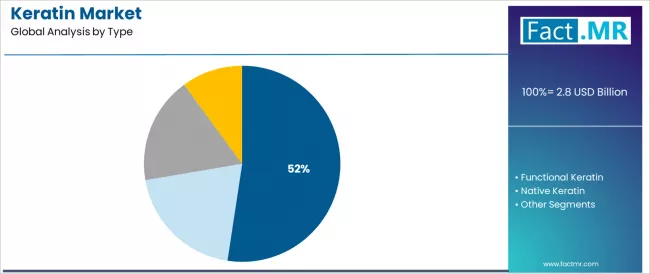
Hydrolyzed keratin is estimated to account for 52.4% of the keratin market share in 2025. The segment's leading position stems from its fundamental role as a critical component in modern hair care applications and its extensive use across multiple beauty and personal care sectors. The hydrolyzed keratin range's dominance is attributed to its superior protein properties, including excellent hair penetration, damage repair capabilities, and balanced cost-effectiveness that make it indispensable for beauty operations.
Hydrolyzed Keratin commands the leading position in the keratin market through advanced protein technologies, including comprehensive hair restoration properties, uniform performance, and reliable protein characteristics that enable operators to deploy keratin across diverse beauty environments. The segment benefits from beauty preference for proven protein interfaces that provide exceptional hair repair performance without requiring ultra-premium protein costs.
Efficient protein implementation enables deployment in salon, consumer, and professional applications where keratin reliability and beauty compatibility represent critical selection requirements. Hydrolyzed keratin differentiates through excellent hair penetration capacity, proven beauty reliability, and compatibility with standard salon processes that enhance keratin capabilities while maintaining economical protein profiles suitable for diverse beauty applications.
Key market characteristics:
- Advanced protein systems with precision hair repair control, consistent restoration properties, and specialized manufacturing capabilities
- Keratin optimization enabling comprehensive beauty integration with minimal hair damage impact
- Beauty accessories, including treatment equipment, application systems, and quality control tools for high-volume operations
By Application, the Hair Care Products Segment Accounts for the Largest Market Share
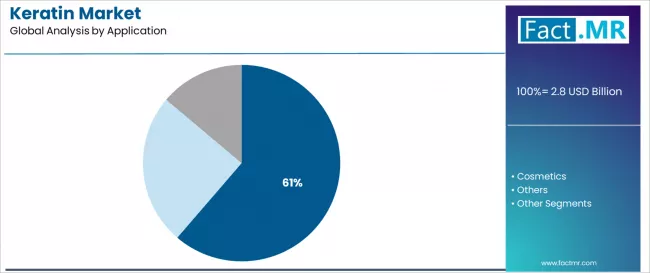
Hair care products are projected to hold 61.0% of the keratin market share in 2025. The segment's market leadership is driven by the extensive use of keratin in shampoo formulations, conditioning systems, hair care manufacturing, and beauty infrastructure, where keratin serves as both a protein component and damage repair solution. The hair care sector's consistent demand for reliable keratin systems supports the segment's dominant position.
Hair care applications dominate the market due to widespread adoption of efficient keratin solutions and increasing focus on hair damage repair, performance optimization, and beauty management that support hair care operations while maintaining quality standards. Hair care consumers prioritize keratin durability, protein performance, and integration with standard beauty systems that enable coordinated deployment across multiple hair care needs. The segment benefits from substantial personal care growth and beauty development that emphasize reliable keratin for consumer applications.
Hair care programs incorporate keratin as standard components for beauty systems and consumer programs. Beauty compliance initiatives are increasing demand for advanced features that comply with hair care standards and enhance system performance. Keratin cost fluctuations and standardization requirements may limit deployment flexibility in ultra-price-sensitive markets or regions with varying beauty requirements.
Application dynamics include:
- Strong growth in beauty companies and personal care manufacturers requiring standardized keratin formats
- Increasing adoption in cosmetics manufacturers and beauty integrators for enhanced hair care development
- Rising integration with salon systems and beauty facility control programs
By End-Use Industry, the Personal Care Industry Segment Demonstrates Strong Growth
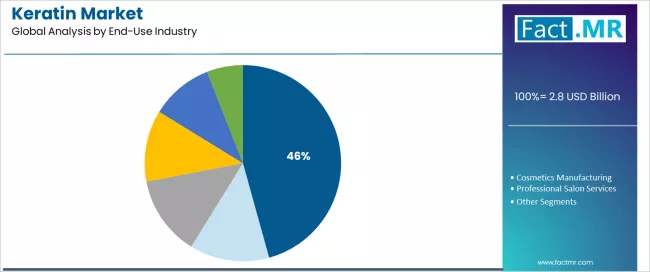
By end-use industry, the personal care segment is anticipated to capture 45.7% of the keratin market share in 2025. The segment's growth is driven by increasing consumer demand, personal care initiatives, and sophisticated protein requirements that require high-quality keratin systems. The personal care industry's expansion and focus on beauty efficiency support this segment's robust performance.
Personal care applications leverage keratin for beauty systems in consumer products, manufacturing operations, formulation processes, and component integration where keratin quality and protein precision are critical performance factors. Rising consumer product production, personal care development trends, and expanding beauty capabilities drive demand for specialized keratin that delivers consistent performance across diverse personal care applications.
What are the Drivers, Restraints, and Key Trends of the Keratin Market?
Hair damage repair expansion drives primary adoption as keratin treatment systems provide exceptional protein restoration properties that enable beauty development without performance compromise, supporting hair repair advancement and operational efficiency that require reliable keratin formats.
Advanced protein growth accelerates market expansion as companies seek specialized keratin that maintains performance during application while enhancing beauty convenience through standardized specifications and compatibility. Beauty awareness increases worldwide, creating continued demand for keratin systems that complement salon routines and provide operational advantages in hair care performance.
Advanced protein cost volatility challenges differ across keratin markets regarding price stability and supply chain consistency, which may limit margin predictability and cost planning in price-sensitive beauty categories with demanding affordability requirements.
Manufacturing complexity persists regarding keratin specifications and beauty standards that may increase production costs in facilities with complex quality protocols. Market fragmentation across multiple keratin specifications and application standards creates compatibility concerns between different protein systems and existing beauty infrastructure.
Adoption accelerates in beauty and personal care sectors where keratin benefits justify equipment investments, with geographic concentration in developed markets transitioning toward mainstream adoption in emerging economies driven by urbanization and beauty expansion.
Technology advancement focuses on enhanced protein properties, improved beauty performance, and integration with automated systems that optimize hair care performance and quality control. The market could face disruption if alternative protein technologies or beauty changes significantly challenge traditional keratin advantages in hair care applications.
Analysis of the Keratin Market by Key Country
The keratin market demonstrates varied regional dynamics with growth leaders including China (9.8% CAGR) and India (8.9% CAGR) driving expansion through beauty infrastructure growth and personal care modernization. Steady Performers encompass Germany (8.1% CAGR), Brazil (7.6% CAGR), and the USA (7.2% CAGR), benefiting from established beauty systems and advanced keratin adoption.
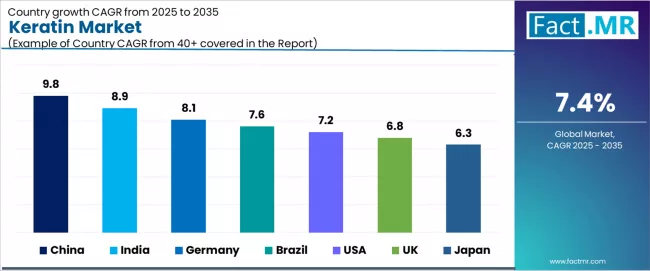
| Country | CAGR (2025-2035) |
|---|---|
| China | 9.8% |
| India | 8.9% |
| Germany | 8.1% |
| Brazil | 7.6% |
| USA | 7.2% |
| UK | 6.8% |
| Japan | 6.3% |
Regional synthesis reveals Asia-Pacific markets leading growth through beauty expansion and personal care development, while European countries maintain steady expansion supported by specialized applications and precision keratin requirements. North American markets show strong growth driven by salon demand and beauty facility upgrades.
China Drives Beauty Infrastructure Leadership
China establishes regional leadership through rapid beauty development and comprehensive personal care modernization, integrating advanced keratin systems as standard components in cosmetic manufacturing and salon operations. The country's 9.8% CAGR through 2035 reflects beauty growth promoting infrastructure development and personal care expansion that mandate the use of reliable keratin systems in beauty operations.
Growth concentrates in major urban centers, including Beijing, Shanghai, and Guangzhou, where beauty networks showcase integrated keratin systems that appeal to manufacturers seeking enhanced production efficiency and international quality standards. Chinese manufacturers are developing innovative keratin solutions that combine local production advantages with international beauty specifications, including advanced protein compositions and enhanced hair repair capabilities.
Strategic Market Indicators:
- Beauty infrastructure growth providing substantial support for domestic personal care development
- Salon capacity expansion driven by beauty development and keratin demand
- Research sector development for cost-effective keratin solutions targeting domestic and export applications
India Demonstrates Personal Care Excellence
The Indian market emphasizes beauty infrastructure applications, including rapid personal care development and comprehensive salon expansion that increasingly incorporates keratin for hair care enhancement and beauty applications. The country is projected to show an 8.9% CAGR through 2035, driven by massive beauty activity under urbanization initiatives and demand for standardized, high-quality keratin systems. Indian beauty facilities prioritize cost-effectiveness with keratin delivering personal care efficiency through economical protein usage and reliable performance capabilities.
Technology deployment channels include major beauty companies, personal care integrators, and salon institutions that support high-volume usage for beauty and hair care applications.
Performance Metrics:
- Beauty facilities in Delhi, Mumbai, and Bangalore leading keratin adoption for personal care operations
- Personal care development compliance with beauty standards, driving quality selection criteria
Germany Drives Beauty Innovation
The German market emphasizes advanced beauty infrastructure features, including innovative keratin technologies and integration with comprehensive personal care platforms that manage salon operations, beauty facilities, and institutional applications through unified keratin systems. The country is projected to show an 8.1% CAGR through 2035, driven by beauty expansion under personal care development trends and demand for premium, reliable keratin systems. German beauty institutions prioritize precision with keratin delivering comprehensive personal care performance through enhanced quality protection and operational innovation.
Technology deployment channels include major beauty companies, personal care institutions, and keratin equipment manufacturers that support custom development for premium operations.
Performance Metrics:
- Beauty companies in Baden-Württemberg, Bavaria, and North Rhine-Westphalia leading keratin adoption for personal care operations
- Personal care compatibility with beauty requirements, driving specification selection criteria
Brazil Drives Regional Beauty Development
In São Paulo, Rio de Janeiro, and Belo Horizonte, Brazilian beauty facilities and personal care operators are implementing advanced keratin systems to enhance protein capabilities and support operational performance that aligns with beauty protocols and personal care standards. The Brazilian market demonstrates continued growth with a 7.6% CAGR through 2035, driven by beauty compliance programs and personal care investments that emphasize reliable keratin systems for salon and consumer applications. Brazilian beauty facilities are prioritizing keratin systems that provide exceptional protein properties while maintaining compliance with personal care standards and minimizing operational complexity, particularly important in salon and beauty facility operations.
Market expansion benefits from personal care programs that mandate enhanced keratin compliance in beauty specifications, creating continued demand across Brazil's salon and consumer sectors, where protein quality and system consistency represent critical requirements.
Strategic Market Indicators:
- Beauty operators and personal care companies leading adoption with compliance programs requiring reliable keratin systems
- Beauty standards providing framework support for high-performance keratin acquisition
- Quality control requirements driving demand for certified systems with performance testing documentation
- Specialized personal care segments adopting comprehensive keratin solutions for beauty facilities and salon projects
United States Maintains Beauty Excellence
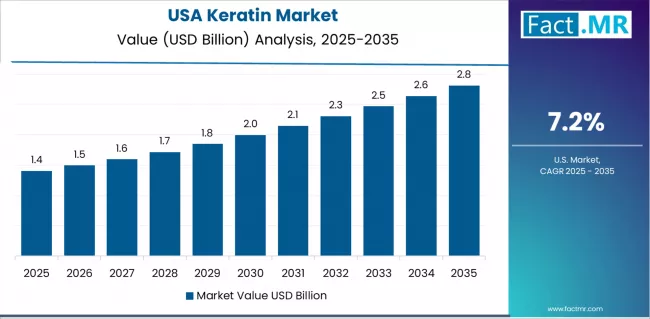
The USA market emphasizes beauty infrastructure features, including innovative keratin technologies and integration with comprehensive personal care platforms that manage salon operations, beauty facilities, and commercial applications through unified keratin systems. The country is projected to show a 7.2% CAGR through 2035, driven by beauty expansion under personal care development trends and industry demand for premium, reliable keratin systems. American beauty companies prioritize innovation with keratin delivering comprehensive personal care performance through enhanced quality protection and operational advancement.
Technology deployment channels include major beauty companies, personal care institutions, and keratin manufacturers that support custom development for beauty operations.
Performance Metrics:
- Beauty companies in California, New York, and Texas leading keratin adoption for personal care operations
- Keratin compatibility with beauty development requirements, driving specification selection criteria
United Kingdom Drives Personal Care Research Leadership
The UK market demonstrates advanced beauty infrastructure deployment, growing at 6.8% CAGR, with documented operational excellence in personal care control and beauty applications through integration with existing personal care systems and quality assurance infrastructure. The country leverages engineering expertise in beauty manufacturing and keratin science to maintain market leadership. Personal care centers, including London, Manchester, and Birmingham, showcase advanced installations where keratin systems integrate with comprehensive beauty platforms and personal care systems to optimize salon development and operational efficiency.
British beauty facilities prioritize keratin precision and system consistency in product selection, creating demand for premium keratin systems with advanced features, including enhanced protein compositions and integration with automated personal care systems. The market benefits from established beauty infrastructure and willingness to invest in specialized keratin technologies that provide superior quality and personal care compliance.
Market Intelligence Brief:
- Precision focus on keratin quality and system uniformity, driving personal care segment growth
- Technology collaboration between British beauty manufacturers and international keratin companies
- Premium personal care systems expanding keratin integration in salon infrastructure and beauty applications
Japan Maintains Quality Precision
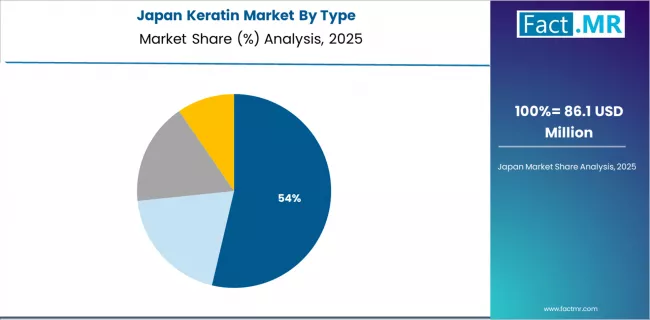
Japan's advanced beauty market demonstrates meticulous keratin deployment, growing at 6.3% CAGR, with documented operational excellence in personal care control and salon applications through integration with existing beauty systems and quality assurance infrastructure. The country leverages engineering expertise in beauty manufacturing and keratin technology to maintain market leadership. Beauty centers, including Tokyo, Osaka, and Nagoya, showcase advanced installations where keratin systems integrate with comprehensive personal care platforms and quality systems to optimize beauty development and operational efficiency.
Japanese beauty facilities prioritize keratin precision and system consistency in product selection, creating demand for premium keratin systems with advanced features, including ultra-high quality and integration with automated personal care protocols. The market benefits from established beauty infrastructure and willingness to invest in specialized keratin technologies that provide superior performance and personal care compliance.
Market Intelligence Brief:
- Precision focus on keratin quality and protein uniformity, driving personal care segment growth
- Technology collaboration between Japanese beauty manufacturers and international keratin companies
- Premium personal care systems expanding keratin integration in salon infrastructure and beauty applications
Europe Market Split by Country
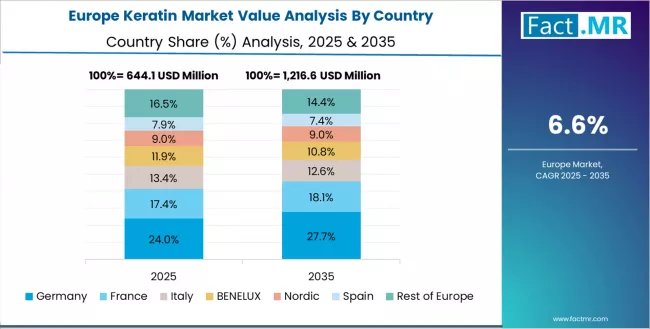
The keratin market in Europe is projected to grow from USD 0.8 billion in 2025 to USD 1.6 billion by 2035, registering a CAGR of 7.4% over the forecast period. Germany is expected to maintain its leadership position with a 35.6% market share in 2025, declining slightly to 35.2% by 2035, supported by its personal care excellence and major beauty centers, including Baden-Württemberg and Bavaria.
France follows with a 26.8% share in 2025, projected to reach 27.1% by 2035, driven by comprehensive beauty programs and personal care facility initiatives. The United Kingdom holds a 18.7% share in 2025, expected to maintain 18.9% by 2035 through established personal care sectors and beauty adoption.
Italy commands a 13.2% share, while Spain accounts for 4.1% in 2025. The Rest of Europe region is anticipated to gain momentum, expanding its collective share from 1.6% to 1.8% by 2035, attributed to increasing beauty development in Eastern European countries and emerging personal care programs implementing standardized keratin systems.
Competitive Landscape of the Keratin Market
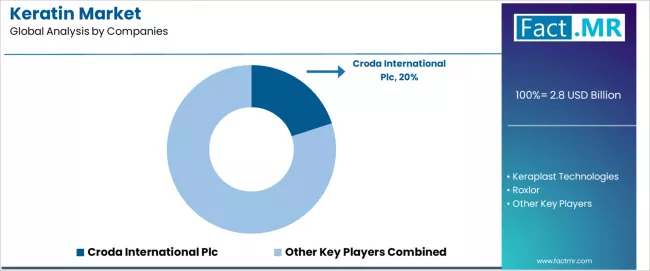
The keratin market operates with moderate concentration, featuring approximately 15-22 participants, where leading companies control roughly 55-62% of the global market share through established distribution networks and comprehensive product portfolio capabilities. Competition emphasizes keratin performance, beauty reliability, and protein optimization rather than premium feature rivalry.
Market leaders encompass Croda International, Keraplast Technologies, and Roxlor, which maintain competitive advantages through extensive beauty infrastructure expertise, regional distribution networks, and comprehensive technical support capabilities that create personal care industry loyalty and support beauty requirements. These companies leverage decades of keratin experience and ongoing personal care technology investments to develop advanced keratin systems with exceptional quality and beauty features.
Specialty challengers include regional manufacturers and keratin specialists, which compete through specialized application innovation focus and efficient production solutions that appeal to beauty buyers seeking reliable performance formats and custom keratin flexibility. These companies differentiate through operational efficiency emphasis and specialized market focus.
Market dynamics favor participants that combine consistent keratin performance with advanced personal care support, including automated systems and distribution capabilities. Competitive pressure intensifies as traditional protein manufacturers expand into keratin systems. Specialized beauty producers challenge established players through innovative manufacturing methods and cost-effective production targeting emerging personal care segments.
Key Players in the Keratin Market
- Croda International Plc
- Keraplast Technologies
- Roxlor
- Seiwa Kasei Co., Ltd.
- KeraTein
- Kelisema
- Kyowa Hakko Bio Co., Ltd.
- Provital Group
- Ichimaru Pharcos Co., Ltd.
- Symrise AG
Scope of the Report
| Item | Value |
|---|---|
| Quantitative Units | USD 2.8 billion |
| Type | Hydrolyzed Keratin, Functional Keratin, Native Keratin, Others |
| Application | Hair Care Products, Cosmetics, Others |
| End-Use Industry | Personal Care Industry, Cosmetics Manufacturing, Professional Salon Services, Beauty Treatments, Hair Restoration Clinics, Specialty Applications |
| Regions Covered | North America, Europe, Asia Pacific, Latin America, Middle East & Africa |
| Countries Covered | China, India, Germany, Brazil, USA, UK, Japan, and 25+ additional countries |
| Key Companies Profiled | Croda International, Keraplast Technologies, Roxlor, Seiwa Kasei |
| Additional Attributes | Dollar sales by type and application categories, regional adoption trends across Asia Pacific, North America, and Europe, competitive landscape with keratin manufacturers and beauty producers, customer preferences for protein characteristics and personal care performance, integration with beauty equipment and salon systems, innovations in keratin technology and advanced personal care systems, and development of specialized keratin solutions with enhanced properties and beauty-grade features |
Keratin Market by Segments
-
Type:
- Hydrolyzed Keratin
- Functional Keratin
- Native Keratin
- Others
-
Application:
- Hair Care Products
- Cosmetics
- Others
-
End-Use Industry:
- Personal Care Industry
- Cosmetics Manufacturing
- Professional Salon Services
- Beauty Treatments
- Hair Restoration Clinics
- Specialty Applications
-
Region:
- North America
- United States
- Canada
- Mexico
- Europe
- Germany
- France
- United Kingdom
- Italy
- Spain
- Nordic
- BENELUX
- Rest of Europe
- Asia Pacific
- China
- Japan
- India
- South Korea
- ASEAN
- Australia & New Zealand
- Rest of Asia Pacific
- Latin America
- Brazil
- Chile
- Rest of Latin America
- Middle East & Africa
- Kingdom of Saudi Arabia
- Other GCC Countries
- Turkey
- South Africa
- Other African Union
- Rest of Middle East & Africa
- North America
Table of Content
- Executive Summary
- Global Market Outlook
- Demand to side Trends
- Supply to side Trends
- Technology Roadmap Analysis
- Analysis and Recommendations
- Market Overview
- Market Coverage / Taxonomy
- Market Definition / Scope / Limitations
- Market Background
- Market Dynamics
- Drivers
- Restraints
- Opportunity
- Trends
- Scenario Forecast
- Demand in Optimistic Scenario
- Demand in Likely Scenario
- Demand in Conservative Scenario
- Opportunity Map Analysis
- Product Life Cycle Analysis
- Supply Chain Analysis
- Investment Feasibility Matrix
- Value Chain Analysis
- PESTLE and Porter’s Analysis
- Regulatory Landscape
- Regional Parent Market Outlook
- Production and Consumption Statistics
- Import and Export Statistics
- Market Dynamics
- Global Market Analysis 2020 to 2024 and Forecast, 2025 to 2035
- Historical Market Size Value (USD Million) Analysis, 2020 to 2024
- Current and Future Market Size Value (USD Million) Projections, 2025 to 2035
- Y to o to Y Growth Trend Analysis
- Absolute $ Opportunity Analysis
- Global Market Pricing Analysis 2020 to 2024 and Forecast 2025 to 2035
- Global Market Analysis 2020 to 2024 and Forecast 2025 to 2035, By Type
- Introduction / Key Findings
- Historical Market Size Value (USD Million) Analysis By Type , 2020 to 2024
- Current and Future Market Size Value (USD Million) Analysis and Forecast By Type , 2025 to 2035
- Hydrolyzed Keratin
- Functional Keratin
- Native Keratin
- Others
- Y to o to Y Growth Trend Analysis By Type , 2020 to 2024
- Absolute $ Opportunity Analysis By Type , 2025 to 2035
- Global Market Analysis 2020 to 2024 and Forecast 2025 to 2035, By Application
- Introduction / Key Findings
- Historical Market Size Value (USD Million) Analysis By Application, 2020 to 2024
- Current and Future Market Size Value (USD Million) Analysis and Forecast By Application, 2025 to 2035
- Hair Care Products
- Cosmetics
- Others
- Y to o to Y Growth Trend Analysis By Application, 2020 to 2024
- Absolute $ Opportunity Analysis By Application, 2025 to 2035
- Global Market Analysis 2020 to 2024 and Forecast 2025 to 2035, By End-Use Industry
- Introduction / Key Findings
- Historical Market Size Value (USD Million) Analysis By End-Use Industry, 2020 to 2024
- Current and Future Market Size Value (USD Million) Analysis and Forecast By End-Use Industry, 2025 to 2035
- Personal Care Industry
- Cosmetics Manufacturing
- Professional Salon Services
- Beauty Treatments
- Hair Restoration Clinics
- Specialty Applications
- Y to o to Y Growth Trend Analysis By End-Use Industry, 2020 to 2024
- Absolute $ Opportunity Analysis By End-Use Industry, 2025 to 2035
- Global Market Analysis 2020 to 2024 and Forecast 2025 to 2035, By Region
- Introduction
- Historical Market Size Value (USD Million) Analysis By Region, 2020 to 2024
- Current Market Size Value (USD Million) Analysis and Forecast By Region, 2025 to 2035
- North America
- Latin America
- Western Europe
- Eastern Europe
- East Asia
- South Asia and Pacific
- Middle East & Africa
- Market Attractiveness Analysis By Region
- North America Market Analysis 2020 to 2024 and Forecast 2025 to 2035, By Country
- Historical Market Size Value (USD Million) Trend Analysis By Market Taxonomy, 2020 to 2024
- Market Size Value (USD Million) Forecast By Market Taxonomy, 2025 to 2035
- By Country
- USA
- Canada
- Mexico
- By Type
- By Application
- By End-Use Industry
- By Country
- Market Attractiveness Analysis
- By Country
- By Type
- By Application
- By End-Use Industry
- Key Takeaways
- Latin America Market Analysis 2020 to 2024 and Forecast 2025 to 2035, By Country
- Historical Market Size Value (USD Million) Trend Analysis By Market Taxonomy, 2020 to 2024
- Market Size Value (USD Million) Forecast By Market Taxonomy, 2025 to 2035
- By Country
- Brazil
- Chile
- Rest of Latin America
- By Type
- By Application
- By End-Use Industry
- By Country
- Market Attractiveness Analysis
- By Country
- By Type
- By Application
- By End-Use Industry
- Key Takeaways
- Western Europe Market Analysis 2020 to 2024 and Forecast 2025 to 2035, By Country
- Historical Market Size Value (USD Million) Trend Analysis By Market Taxonomy, 2020 to 2024
- Market Size Value (USD Million) Forecast By Market Taxonomy, 2025 to 2035
- By Country
- Germany
- UK
- Italy
- Spain
- France
- Nordic
- BENELUX
- Rest of Western Europe
- By Type
- By Application
- By End-Use Industry
- By Country
- Market Attractiveness Analysis
- By Country
- By Type
- By Application
- By End-Use Industry
- Key Takeaways
- Eastern Europe Market Analysis 2020 to 2024 and Forecast 2025 to 2035, By Country
- Historical Market Size Value (USD Million) Trend Analysis By Market Taxonomy, 2020 to 2024
- Market Size Value (USD Million) Forecast By Market Taxonomy, 2025 to 2035
- By Country
- Russia
- Poland
- Hungary
- Balkan & Baltic
- Rest of Eastern Europe
- By Type
- By Application
- By End-Use Industry
- By Country
- Market Attractiveness Analysis
- By Country
- By Type
- By Application
- By End-Use Industry
- Key Takeaways
- East Asia Market Analysis 2020 to 2024 and Forecast 2025 to 2035, By Country
- Historical Market Size Value (USD Million) Trend Analysis By Market Taxonomy, 2020 to 2024
- Market Size Value (USD Million) Forecast By Market Taxonomy, 2025 to 2035
- By Country
- China
- Japan
- South Korea
- By Type
- By Application
- By End-Use Industry
- By Country
- Market Attractiveness Analysis
- By Country
- By Type
- By Application
- By End-Use Industry
- Key Takeaways
- South Asia and Pacific Market Analysis 2020 to 2024 and Forecast 2025 to 2035, By Country
- Historical Market Size Value (USD Million) Trend Analysis By Market Taxonomy, 2020 to 2024
- Market Size Value (USD Million) Forecast By Market Taxonomy, 2025 to 2035
- By Country
- India
- ASEAN
- Australia & New Zealand
- Rest of South Asia and Pacific
- By Type
- By Application
- By End-Use Industry
- By Country
- Market Attractiveness Analysis
- By Country
- By Type
- By Application
- By End-Use Industry
- Key Takeaways
- Middle East & Africa Market Analysis 2020 to 2024 and Forecast 2025 to 2035, By Country
- Historical Market Size Value (USD Million) Trend Analysis By Market Taxonomy, 2020 to 2024
- Market Size Value (USD Million) Forecast By Market Taxonomy, 2025 to 2035
- By Country
- Kingdom of Saudi Arabia
- Other GCC Countries
- Turkiye
- South Africa
- Other African Union
- Rest of Middle East & Africa
- By Type
- By Application
- By End-Use Industry
- By Country
- Market Attractiveness Analysis
- By Country
- By Type
- By Application
- By End-Use Industry
- Key Takeaways
- Key Countries Market Analysis
- USA
- Pricing Analysis
- Market Share Analysis, 2024
- By Type
- By Application
- By End-Use Industry
- Canada
- Pricing Analysis
- Market Share Analysis, 2024
- By Type
- By Application
- By End-Use Industry
- Mexico
- Pricing Analysis
- Market Share Analysis, 2024
- By Type
- By Application
- By End-Use Industry
- Brazil
- Pricing Analysis
- Market Share Analysis, 2024
- By Type
- By Application
- By End-Use Industry
- Chile
- Pricing Analysis
- Market Share Analysis, 2024
- By Type
- By Application
- By End-Use Industry
- Germany
- Pricing Analysis
- Market Share Analysis, 2024
- By Type
- By Application
- By End-Use Industry
- UK
- Pricing Analysis
- Market Share Analysis, 2024
- By Type
- By Application
- By End-Use Industry
- Italy
- Pricing Analysis
- Market Share Analysis, 2024
- By Type
- By Application
- By End-Use Industry
- Spain
- Pricing Analysis
- Market Share Analysis, 2024
- By Type
- By Application
- By End-Use Industry
- France
- Pricing Analysis
- Market Share Analysis, 2024
- By Type
- By Application
- By End-Use Industry
- India
- Pricing Analysis
- Market Share Analysis, 2024
- By Type
- By Application
- By End-Use Industry
- ASEAN
- Pricing Analysis
- Market Share Analysis, 2024
- By Type
- By Application
- By End-Use Industry
- Australia & New Zealand
- Pricing Analysis
- Market Share Analysis, 2024
- By Type
- By Application
- By End-Use Industry
- China
- Pricing Analysis
- Market Share Analysis, 2024
- By Type
- By Application
- By End-Use Industry
- Japan
- Pricing Analysis
- Market Share Analysis, 2024
- By Type
- By Application
- By End-Use Industry
- South Korea
- Pricing Analysis
- Market Share Analysis, 2024
- By Type
- By Application
- By End-Use Industry
- Russia
- Pricing Analysis
- Market Share Analysis, 2024
- By Type
- By Application
- By End-Use Industry
- Poland
- Pricing Analysis
- Market Share Analysis, 2024
- By Type
- By Application
- By End-Use Industry
- Hungary
- Pricing Analysis
- Market Share Analysis, 2024
- By Type
- By Application
- By End-Use Industry
- Kingdom of Saudi Arabia
- Pricing Analysis
- Market Share Analysis, 2024
- By Type
- By Application
- By End-Use Industry
- Turkiye
- Pricing Analysis
- Market Share Analysis, 2024
- By Type
- By Application
- By End-Use Industry
- South Africa
- Pricing Analysis
- Market Share Analysis, 2024
- By Type
- By Application
- By End-Use Industry
- USA
- Market Structure Analysis
- Competition Dashboard
- Competition Benchmarking
- Market Share Analysis of Top Players
- By Regional
- By Type
- By Application
- By End-Use Industry
- Competition Analysis
- Competition Deep Dive
- Croda International Plc
- Overview
- Product Portfolio
- Profitability by Market Segments (Product/Age /Sales Channel/Region)
- Sales Footprint
- Strategy Overview
- Marketing Strategy
- Product Strategy
- Channel Strategy
- Keraplast Technologies
- Roxlor
- Seiwa Kasei Co., Ltd.
- KeraTein
- Kelisema
- Kyowa Hakko Bio Co., Ltd.
- Provital Group
- Ichimaru Pharcos Co., Ltd.
- Symrise AG
- Croda International Plc
- Competition Deep Dive
- Assumptions & Acronyms Used
- Research Methodology
List Of Table
- Table 1: Global Market Value (USD Million) Forecast by Region, 2020 to 2035
- Table 2: Global Market Value (USD Million) Forecast by Type , 2020 to 2035
- Table 3: Global Market Value (USD Million) Forecast by Application, 2020 to 2035
- Table 4: Global Market Value (USD Million) Forecast by End-Use Industry, 2020 to 2035
- Table 5: North America Market Value (USD Million) Forecast by Country, 2020 to 2035
- Table 6: North America Market Value (USD Million) Forecast by Type , 2020 to 2035
- Table 7: North America Market Value (USD Million) Forecast by Application, 2020 to 2035
- Table 8: North America Market Value (USD Million) Forecast by End-Use Industry, 2020 to 2035
- Table 9: Latin America Market Value (USD Million) Forecast by Country, 2020 to 2035
- Table 10: Latin America Market Value (USD Million) Forecast by Type , 2020 to 2035
- Table 11: Latin America Market Value (USD Million) Forecast by Application, 2020 to 2035
- Table 12: Latin America Market Value (USD Million) Forecast by End-Use Industry, 2020 to 2035
- Table 13: Western Europe Market Value (USD Million) Forecast by Country, 2020 to 2035
- Table 14: Western Europe Market Value (USD Million) Forecast by Type , 2020 to 2035
- Table 15: Western Europe Market Value (USD Million) Forecast by Application, 2020 to 2035
- Table 16: Western Europe Market Value (USD Million) Forecast by End-Use Industry, 2020 to 2035
- Table 17: Eastern Europe Market Value (USD Million) Forecast by Country, 2020 to 2035
- Table 18: Eastern Europe Market Value (USD Million) Forecast by Type , 2020 to 2035
- Table 19: Eastern Europe Market Value (USD Million) Forecast by Application, 2020 to 2035
- Table 20: Eastern Europe Market Value (USD Million) Forecast by End-Use Industry, 2020 to 2035
- Table 21: East Asia Market Value (USD Million) Forecast by Country, 2020 to 2035
- Table 22: East Asia Market Value (USD Million) Forecast by Type , 2020 to 2035
- Table 23: East Asia Market Value (USD Million) Forecast by Application, 2020 to 2035
- Table 24: East Asia Market Value (USD Million) Forecast by End-Use Industry, 2020 to 2035
- Table 25: South Asia and Pacific Market Value (USD Million) Forecast by Country, 2020 to 2035
- Table 26: South Asia and Pacific Market Value (USD Million) Forecast by Type , 2020 to 2035
- Table 27: South Asia and Pacific Market Value (USD Million) Forecast by Application, 2020 to 2035
- Table 28: South Asia and Pacific Market Value (USD Million) Forecast by End-Use Industry, 2020 to 2035
- Table 29: Middle East & Africa Market Value (USD Million) Forecast by Country, 2020 to 2035
- Table 30: Middle East & Africa Market Value (USD Million) Forecast by Type , 2020 to 2035
- Table 31: Middle East & Africa Market Value (USD Million) Forecast by Application, 2020 to 2035
- Table 32: Middle East & Africa Market Value (USD Million) Forecast by End-Use Industry, 2020 to 2035
List Of Figures
- Figure 1: Global Market Pricing Analysis
- Figure 2: Global Market Value (USD Million) Forecast 2020-2035
- Figure 3: Global Market Value Share and BPS Analysis by Type , 2025 and 2035
- Figure 4: Global Market Y to o to Y Growth Comparison by Type , 2025-2035
- Figure 5: Global Market Attractiveness Analysis by Type
- Figure 6: Global Market Value Share and BPS Analysis by Application, 2025 and 2035
- Figure 7: Global Market Y to o to Y Growth Comparison by Application, 2025-2035
- Figure 8: Global Market Attractiveness Analysis by Application
- Figure 9: Global Market Value Share and BPS Analysis by End-Use Industry, 2025 and 2035
- Figure 10: Global Market Y to o to Y Growth Comparison by End-Use Industry, 2025-2035
- Figure 11: Global Market Attractiveness Analysis by End-Use Industry
- Figure 12: Global Market Value (USD Million) Share and BPS Analysis by Region, 2025 and 2035
- Figure 13: Global Market Y to o to Y Growth Comparison by Region, 2025-2035
- Figure 14: Global Market Attractiveness Analysis by Region
- Figure 15: North America Market Incremental Dollar Opportunity, 2025-2035
- Figure 16: Latin America Market Incremental Dollar Opportunity, 2025-2035
- Figure 17: Western Europe Market Incremental Dollar Opportunity, 2025-2035
- Figure 18: Eastern Europe Market Incremental Dollar Opportunity, 2025-2035
- Figure 19: East Asia Market Incremental Dollar Opportunity, 2025-2035
- Figure 20: South Asia and Pacific Market Incremental Dollar Opportunity, 2025-2035
- Figure 21: Middle East & Africa Market Incremental Dollar Opportunity, 2025-2035
- Figure 22: North America Market Value Share and BPS Analysis by Country, 2025 and 2035
- Figure 23: North America Market Value Share and BPS Analysis by Type , 2025 and 2035
- Figure 24: North America Market Y to o to Y Growth Comparison by Type , 2025-2035
- Figure 25: North America Market Attractiveness Analysis by Type
- Figure 26: North America Market Value Share and BPS Analysis by Application, 2025 and 2035
- Figure 27: North America Market Y to o to Y Growth Comparison by Application, 2025-2035
- Figure 28: North America Market Attractiveness Analysis by Application
- Figure 29: North America Market Value Share and BPS Analysis by End-Use Industry, 2025 and 2035
- Figure 30: North America Market Y to o to Y Growth Comparison by End-Use Industry, 2025-2035
- Figure 31: North America Market Attractiveness Analysis by End-Use Industry
- Figure 32: Latin America Market Value Share and BPS Analysis by Country, 2025 and 2035
- Figure 33: Latin America Market Value Share and BPS Analysis by Type , 2025 and 2035
- Figure 34: Latin America Market Y to o to Y Growth Comparison by Type , 2025-2035
- Figure 35: Latin America Market Attractiveness Analysis by Type
- Figure 36: Latin America Market Value Share and BPS Analysis by Application, 2025 and 2035
- Figure 37: Latin America Market Y to o to Y Growth Comparison by Application, 2025-2035
- Figure 38: Latin America Market Attractiveness Analysis by Application
- Figure 39: Latin America Market Value Share and BPS Analysis by End-Use Industry, 2025 and 2035
- Figure 40: Latin America Market Y to o to Y Growth Comparison by End-Use Industry, 2025-2035
- Figure 41: Latin America Market Attractiveness Analysis by End-Use Industry
- Figure 42: Western Europe Market Value Share and BPS Analysis by Country, 2025 and 2035
- Figure 43: Western Europe Market Value Share and BPS Analysis by Type , 2025 and 2035
- Figure 44: Western Europe Market Y to o to Y Growth Comparison by Type , 2025-2035
- Figure 45: Western Europe Market Attractiveness Analysis by Type
- Figure 46: Western Europe Market Value Share and BPS Analysis by Application, 2025 and 2035
- Figure 47: Western Europe Market Y to o to Y Growth Comparison by Application, 2025-2035
- Figure 48: Western Europe Market Attractiveness Analysis by Application
- Figure 49: Western Europe Market Value Share and BPS Analysis by End-Use Industry, 2025 and 2035
- Figure 50: Western Europe Market Y to o to Y Growth Comparison by End-Use Industry, 2025-2035
- Figure 51: Western Europe Market Attractiveness Analysis by End-Use Industry
- Figure 52: Eastern Europe Market Value Share and BPS Analysis by Country, 2025 and 2035
- Figure 53: Eastern Europe Market Value Share and BPS Analysis by Type , 2025 and 2035
- Figure 54: Eastern Europe Market Y to o to Y Growth Comparison by Type , 2025-2035
- Figure 55: Eastern Europe Market Attractiveness Analysis by Type
- Figure 56: Eastern Europe Market Value Share and BPS Analysis by Application, 2025 and 2035
- Figure 57: Eastern Europe Market Y to o to Y Growth Comparison by Application, 2025-2035
- Figure 58: Eastern Europe Market Attractiveness Analysis by Application
- Figure 59: Eastern Europe Market Value Share and BPS Analysis by End-Use Industry, 2025 and 2035
- Figure 60: Eastern Europe Market Y to o to Y Growth Comparison by End-Use Industry, 2025-2035
- Figure 61: Eastern Europe Market Attractiveness Analysis by End-Use Industry
- Figure 62: East Asia Market Value Share and BPS Analysis by Country, 2025 and 2035
- Figure 63: East Asia Market Value Share and BPS Analysis by Type , 2025 and 2035
- Figure 64: East Asia Market Y to o to Y Growth Comparison by Type , 2025-2035
- Figure 65: East Asia Market Attractiveness Analysis by Type
- Figure 66: East Asia Market Value Share and BPS Analysis by Application, 2025 and 2035
- Figure 67: East Asia Market Y to o to Y Growth Comparison by Application, 2025-2035
- Figure 68: East Asia Market Attractiveness Analysis by Application
- Figure 69: East Asia Market Value Share and BPS Analysis by End-Use Industry, 2025 and 2035
- Figure 70: East Asia Market Y to o to Y Growth Comparison by End-Use Industry, 2025-2035
- Figure 71: East Asia Market Attractiveness Analysis by End-Use Industry
- Figure 72: South Asia and Pacific Market Value Share and BPS Analysis by Country, 2025 and 2035
- Figure 73: South Asia and Pacific Market Value Share and BPS Analysis by Type , 2025 and 2035
- Figure 74: South Asia and Pacific Market Y to o to Y Growth Comparison by Type , 2025-2035
- Figure 75: South Asia and Pacific Market Attractiveness Analysis by Type
- Figure 76: South Asia and Pacific Market Value Share and BPS Analysis by Application, 2025 and 2035
- Figure 77: South Asia and Pacific Market Y to o to Y Growth Comparison by Application, 2025-2035
- Figure 78: South Asia and Pacific Market Attractiveness Analysis by Application
- Figure 79: South Asia and Pacific Market Value Share and BPS Analysis by End-Use Industry, 2025 and 2035
- Figure 80: South Asia and Pacific Market Y to o to Y Growth Comparison by End-Use Industry, 2025-2035
- Figure 81: South Asia and Pacific Market Attractiveness Analysis by End-Use Industry
- Figure 82: Middle East & Africa Market Value Share and BPS Analysis by Country, 2025 and 2035
- Figure 83: Middle East & Africa Market Value Share and BPS Analysis by Type , 2025 and 2035
- Figure 84: Middle East & Africa Market Y to o to Y Growth Comparison by Type , 2025-2035
- Figure 85: Middle East & Africa Market Attractiveness Analysis by Type
- Figure 86: Middle East & Africa Market Value Share and BPS Analysis by Application, 2025 and 2035
- Figure 87: Middle East & Africa Market Y to o to Y Growth Comparison by Application, 2025-2035
- Figure 88: Middle East & Africa Market Attractiveness Analysis by Application
- Figure 89: Middle East & Africa Market Value Share and BPS Analysis by End-Use Industry, 2025 and 2035
- Figure 90: Middle East & Africa Market Y to o to Y Growth Comparison by End-Use Industry, 2025-2035
- Figure 91: Middle East & Africa Market Attractiveness Analysis by End-Use Industry
- Figure 92: Global Market - Tier Structure Analysis
- Figure 93: Global Market - Company Share Analysis
- FAQs -
How big is the keratin market in 2025?
The global keratin market is estimated to be valued at USD 2.8 billion in 2025.
What will be the size of keratin market in 2035?
The market size for the keratin market is projected to reach USD 5.7 billion by 2035.
How much will be the keratin market growth between 2025 and 2035?
The keratin market is expected to grow at a 7.4% CAGR between 2025 and 2035.
What are the key product types in the keratin market?
The key product types in keratin market are hydrolyzed keratin, functional keratin, native keratin and others.
Which application segment to contribute significant share in the keratin market in 2025?
In terms of application, hair care products segment to command 61.3% share in the keratin market in 2025.